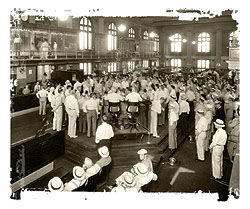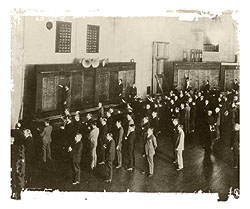Significant Dates in CFTC History — 1970s
Table Of Contents

KCBT Trading Floor, July 19, 1932.
Photo provided by Kansas City Board of Trade

CME Trading Floor soon after 1928 Opening.
Photo provided by Chicago Mercantile Exchange
October 23-24, 1974—Congress passes the Commodity Futures Trading Commission Act of 1974, and it is signed by President Gerald Ford. The bill overhauls the CEA and creates the CFTC, an independent agency with exclusive jurisdiction over futures.
April 21, 1975—Authority for the regulation of futures trading is transferred from the Commodity Exchange Authority, an agency in the USDA, to the CFTC.
September 11, 1975—The CFTC approves the first futures contract on a financial instrument—the CBOT Government National Mortgage Association (Ginnie Mae) certificates futures contract.
April 28, 1977—The CFTC asks the U.S. District Court in Chicago to order seven members of the Hunt family of Dallas, and a related company, to liquidate positions that exceed the three million bushel speculative position limit for soybean futures on the CBOT.
June 1, 1978—The CFTC suspends most commodity options transactions in the U.S. because of pervasive fraud in so-called “London options” and dealer options on physical commodities.
March 16, 1979—In an emergency action, the CFTC votes to prohibit further trading in the CBOT March wheat futures contract, the first time the Commission orders a market closed in the interest of preventing a price manipulation.
September 12, 1979—The Court of Appeals for the Seventh Circuit affirms the CFTC’s authority to act during market emergencies.
| FY 1975 |
FY 1976 |
FY 1977 |
FY 1978 |
FY 1979 |
|
|---|---|---|---|---|---|
| Actual FTE | 502 | 533 | 495 | 474 | 482 |
| Approved Appropriation | $7 | $10 | $13 | $13 | $15 |



